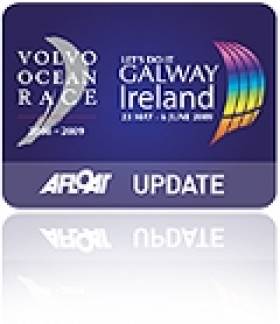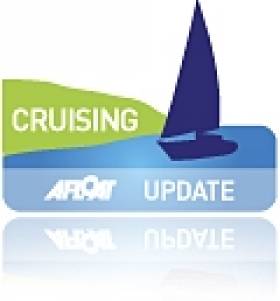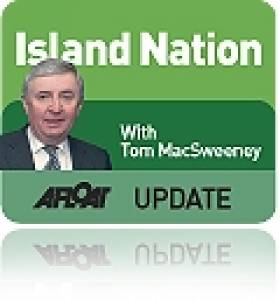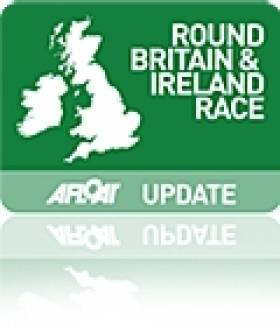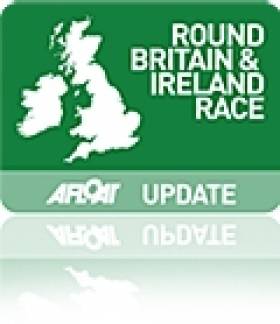Displaying items by tag: Franck Cammas
Cammas Could Be Back On Board Next Month After Nearly Losing Foot
#FranckCammas - French America's Cup skipper Franck Cammas could be returning to the water as soon as next month after nearing losing his foot in a boating accident late last year.
As previously reported on Afloat.ie, Team France's top man had his right foot "partially severed" when he was run over by the rudder of his foiling catamaran during training in Brittany in late November.
However, after successful surgery Cammas was assured he would not lose the use of his foot as the arteries and nerves were unaffected.
And according to Bermuda's Royal Gazette, the Solitaire veteran and Volvo Ocean Race winner is making significant progress in rehab for his injury.
“Now I can spend more time onshore working with the designers and engineers on the new boat,” he said after having his cast removed last week.
It's thought that Cammas could be back on board in time for the resumption of the America's Cup World Series in Oman on 27-28 February.
The Royal Gazette has more on the story HERE.
French America's Cup Skipper Franck Cammas Has Foot 'Partially Severed'
French America's Cup skipper Franck Cammas has had his right foot "partially severed" after he was run over by the rudder of his foiling catamaran after falling overboard.
The accident happened as Team France began a training block in Quiberon Bay, Brittany.
They were using two GC32 catamarans with Cammas in charge of one.
According to French newspaper Le Telegramme, Cammas suffered an open fracture at the bottom of the right tibia, leaving the foot "partially severed", from the accident.
Cammas fell overboard and was run over by the rudder of the boat while it was foiling at speed, his team reports. His right leg was badly injured.
The newspaper said Cammas was quickly recovered by a support boat and taken to shore, where he was airlifted by helicopter to Nantes hospital.
He was facing surgery. Duncan Johnstone has more here
Banque Populaire V Takes Jules Verne Trophy, Smashing World Record
#WORLD RECORD - France's Banque Populaire V has smashed the record for the fastest yacht sailing around the world, shaving nearly three days off the previous best.
BBC News reports that the yacht's 14-man crew crossed the line at 45 days, 13 hours, 42 minutes and 53 seconds to claim the Jules Verne Trophy - knocking 2 days, 18 hours, 1 minute and 59 seconds off the standing world record set by Groupama 3 nearly two years ago.
The 40-metre trimaran, which last year also set a record time in the gruelling Fastnet Race, raced around the globe with an average speed of 26.5 knots.
And the Loïck Peyron-skippered yacht would have beaten the challenge even sooner had it not been delayed for almost two days due to bad weather.
"It was an amazing feeling crossing the line," said crew member Brian Thompson in an audio interview with sailor Hannah White.
Franck Cammas, skipper of Groupama 3 and currently competing in the Volvo Ocean Race, also offered his congratulations to the Banque Populaire team.
"Obviously it's a superb performance as it's always complicated to sail around the world," he told Sail World. "Aboard boats which go so fast, you have to know how to keep pace and drive them at the right speed so as not to break them.
"The crew of Banque Populaire knew how to do it and they did a fine job."
VOR Skipper Cammas Receives French Sporting Honour
Volvo Ocean Race skipper Franck Cammas has been presented with one of France’s most prestigious sporting honours.
The man in charge of the Groupama sailing team was awarded the Grand Prix de l’Académie des Sports in Paris recently, recognising his achievements in sailing in 2010.
These included his skippering of the 100ft trimaran Groupama 3 non-stop around the world in a record-breaking in 48 days, 7 hours, 44 minutes and 52 seconds.
Cammas is only the fifth sailor to be presented with the award, following Whitbread Round the World Race skipper Eric Tabarly, 1983 America’s Cup winner John Bertrand, solo sailor Isabelle Autissier and Alinghi team principal Ernesto Bertarelli.
But Cammas isn't resting on his laurels, as he's currently preparing with his team to compete in the next Volvo Ocean Race kicking off next month.
He will lead a crew of 11 sailors - including Kerryman Damian Foxall - on the 70ft monohull Volvo Open 70 Groupama 4 in the 39,000 nautical mile race, which is set to conclude in Galway next summer and will also involve Wexford sailor Justin Slattery, who is in the crew for Team Abu Dhabi.
The action starts in Alicante, Spain on 29 October with the first in-port race. The first leg to Cape Town then begins on 5 November.
Irish Cruising Club Present Fastnet Award to Killian Bushe
So whenever a high-powered strongly-resourced international challenge is taking shape, Bushe is the boat-builder of choice, favoured by leading designers and top skippers alike. But if you have a challenge in mind and he is top of the list, please join the queue.
For at the moment, he is immersed as leading consultant in building the new Groupama 4, the top French Volvo 70 for Franck Cammas. Before that, he built the two successful Ericsson boats for the last Volvo – they took first and fourth. In fact, he has built the overall winners of the last three Volvo races. And when Groupama 4 is launched in May and signed off for the race (which starts on October 29th) Bushe returns his focus to Sweden which is now his home, where he has been involved with the Artemis challenger for the America's Cup 2013.
For that project, the designer is Juan Kouyoumdjian, and the skipper is Paul Cayard. This is stratospheric stuff, but that's the level where Bushe operates. With more than thirty years of high tech boat building experience, and a string of success that is mind-boggling, he is the gold standard. But beyond that, he is still the Crosshaven kid who started his racing on his father George's Avocet (which George designed and built), and internationally he is the spirit of Cork sailing.
His renowned skill and knowledge in the use of advanced materials and composites is such that you'd expect him to be awarded a Honorary Doctorate in chemistry from some appropriate university. But in the meantime, his special place in Irish and world sailing was honoured on Saturday March 26th with his award of the Fastnet Trophy.
This trophy is co-ordinated by the Irish Cruising Club, and it operates in very broad brief. Initiated in 2005 with its first award to Paddy Barry and Jarlath Cunnane for their pioneering circuit of the Arctic via both the Northwest Passage and the Northeast Passage, its unique lineage has been maintained by such awardees as Robin Knox-Johnston, and the most recent one, centenarian circumnavigator Bill King of Galway.
The Fastnet Trophy is envisaged as highlighting a contribution to sailing which has a sense of the unique about it, and Killian Bushe is just the man. His international sailing achievements began back in 1976 when he was one of the crew that won the Half Ton Cup at Trieste in the Cork-built Silver Shamrock. They celebrated by sailing up the Grand Canal in Venice with spinnaker set. But gradually the boat-building took over, though Bushe sails with his family in Sweden whenever he can. That is what was being celebrated on Saturday night. Killian Bushe – very good sailor, extremely good boatbuilder.
Damian Foxall is First Choice
"When Damian is on a project, it is often the winning one. As such, it is better to have him with us rather than against us."
That tribute to Damian Foxall comes from Franck Cammas, renowned amongst the top sailors in the world. In France his sporting fame lies somewhere between rock star and iconic status. He has a record-breaking career. This year he added two world races to his achievements, the Jules Verne Trophy and the Route du Rhumm.
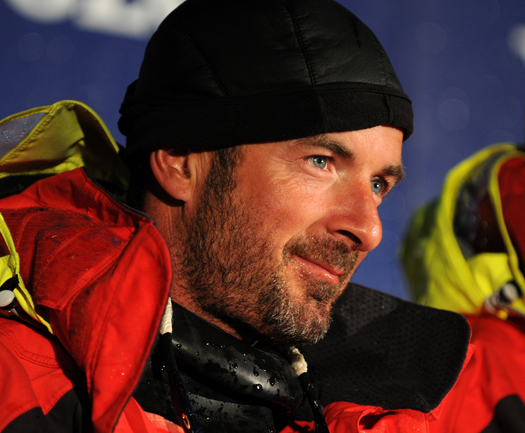
Ireland's Offshore Ace Damian Foxall has joined Groupama for the next Ocean Race
He races "anything and everything that floats" and his reputation is so strong that the huge worldwide Groupama insurance company has committed over a decade of sponsorship support to his projects. In return he has carried their name on a winning partnership with five world records amongst the list of successes. That kind of dedication from a backer is almost unheard of in any sport and has provided the financial muscle to confirm that Camas will lead the entry of boats into the Volvo Ocean Race around the world until 2015.
"Our commitment is to a race that, given its longevity on the circuit, has a human dimension and an international relevance," said Groupama Managing Director Jean Azéma. "We chose the Volvo to promote our image and share the benefit with Franck Cammas who is a sporting icon. Both of us, through the boat named Groupama, are interested in the values of building a boat, a sport and a reputation, with human interest. This is something that will last."
That huge commitment contrasts with the on-going financial struggle to enter an Irish boat. Damian, who crewed the last Irish entry, the Green Dragon, is no longer available, having been given a huge endorsement and tribute by Cammas who chose him first as an essential part of the Groupama entry.
He named the Kerryman, from Derrynane, as the first sailor he wanted aboard. Foxall, at the age of 41, is arguably the most French of Irishmen. Now resident in Lorient, he has taken part in three Volvo Ocean Races and won the last Barcelona two-crew non/stop round-the-world race with Jean-Pierre Dick.
He has been appointed to three responsibilities, as Helmsman, Trimmer and Crew Manager and is enthusiastic about going around the world for a sixth time, having also been part of a non/stop world speed record:
"I have been involved with Franck since the outset of this entry. The greatest challenge is to drive Groupama 4 at one hundred per cent of her potential at each of the nine stages of the race, with very little time during the stopovers. In a nine-month race fatigue accumulates. At the end, you really feel that you've done a circumnavigation of the globe."
Damian has worked alongside Cammas to select the sailing crew for next year's race. They include top international sailing names: Philip Harmer, Magnus Woxén, Jean-Luc Nélias, Charles Caudrelier, Sébastien Josse, Yann Riou, Jacques Caraës, Martin Krite, Brad Marsh, Martin Strömberg, Erwan Israël and Sébastien Marsset.
The Groupama project bought the winning boat in the last Volvo Race, the Volvo 70, Ericsson 4, which they rechristened, Groupama 70 and which they have been using for training. That shows their financial resources.
For the design of Groupama 4, their new boat for the 2011 event which will start next October, they turned to Juan Koujoumdjian, who was involved in building the last two winning Volvo boats, Ericsson 4 and ABN Amro One. The design is being tested in sailing trials off Lorient in Brittany where the team is based and which is Foxall's home base.
Cammas has put together a strong Groupama Sailing Team, with Foxall's input. Another Green Dragon sailor has been chosen as Pitman, Master Sailmaker and to back-up Damian as Helmsman and Trimmer. He is Australian Phil Harmer for whom this will be his third Volvo: "I feel really lucky to be in the Groupama Team. I sailed with Damian on Green Dragon and he called me to ask me to join. Since then I've had other offers, but I don't want to leave Groupama. There's a strong sense of involvement and no other team is in a position to do better."
This article is reprinted by permission of the EVENING ECHO newspaper, Cork, where Tom MacSweeney writes maritime columns twice weekly. Evening Echo website: www.eecho.ie
Cammas Sets New Round Britain and Ireland Record
Groupama completed the 1802 mile course in 5 Days 21 Hours 26 minutes and 55 seconds, smashing the course record by 14 hours 3 minutes and 8 seconds.
There were emotional scenes on board as Franck Cammas and his crew crossed the finish line. It was a triumphant finale for Groupama in sharp contrast to the star, when they were the last boat to cross the line, after they had been damaged on their mooring.
"I definitely preferred the finish to the start," smiled Franck Cammas, surrounded by the media dockside after the finish. "It was difficult for us to give away five miles to Teléfonica, but very nice for all of the boats to see us charging through them in the Solent. This race has been so helpful to Groupama. The course is like a mini Volvo Ocean Race. It has all of the different conditions that we will encounter and it has been really good to race against Teléfonica. The crew has really got to know each other well and we have made some fantastic progress in our development over the last few days. Best wishes to everyone who will finish the race, it is a great achievement."
Groupama Sets Pace Round Britain and Ireland
Almost exactly two days into the Sevenstar Round Britain and Ireland Race, Franck Cammas' Volvo Open 70, Groupama, was the first yacht to round Muckle Flugga at 1400 BST. They are now heading southwest at a speed of over 17 knots with their 19-mile lead rapidly increasing over their rivals Telefonica Azul, who are still beating up to Muckle Flugga reports Louay Habib.
Jonny Malbon's IMOCA 60, Artemis Ocean Racing, has 77 miles to go to reach the top of the course and will round the remote island alone, as they have been for much of this race. On board is Olympic 49er medallist, Simon Hiscocks who is very much at home racing a 49er or an extreme 40, but offshore racing is a very new concept to him. (See Simon's video blog http://sevenstar.rorc.org/newsblogsphotos.html
Artemis Ocean Racing is going well and 48 hours into the race they are second overall under IRC behind Piet Vroon's Ker 46, Tonnerre de Breskens. Early leaders on handicap, the British Keelboat Academy's TP52, John Merricks II, are now third overall but sailing further offshore and look to be getting into more breeze.
Meanwhile the young crew on Tony Lawson's Class 40, Concise are feeling the effects of this brutal race. "We are cold, wet and busting a gut to keep up with the bigger boats in front of us." Said Tom Gall, skipper of Concise. "The boat has been like a submarine since we left Cowes and we are living off tea and porridge. Tom Dawson comes from Newcastle, and when we passed his home town, he told us how good the fish and chips are. I must say I was licking my lips when I told him to belt-up. This is a tough, tough race but when I look at the crew around me, I just well up with pride for what we are doing."
In IRC Two, Adrian Lower's Swan 44, Selene, is top of the class and has opened up a nine-mile lead on Harry Heijst's S&S 41, Winsome. This may be down to their secret weapon, Tabasco: "We have more bottles of the pepper sauce on board than we have crew," admitted Adrian. "It helps spice up the bland food and warms up the lads as we go north. We are taking part in this race, partly for the challenge of sailing round our Island non-stop, but also to show that an old boat can be competitive."
Driving rain is sweeping across the racecourse but the good news is that the severe weather predicted for Thursday may well be further south than expected. Lighter conditions may well prevail tonight, but one thing that is certain about the Sevenstar Round Britain and Ireland Race; nothing can be taken for granted.
ENDS/...
The Sevenstar Round Britain and Ireland Race is being tracked with OCTrackers. Each boat is supplied with an OCTracker beacon, a self contained unit that transmits the position of the boat at regular intervals using GPS. You can watch the race as it unfolds by visiting: http://sevenstar.rorc.org/tracking.html
22,000 people are also playing the virtual race game. It's not too late to join the race. Sign up via the website: (http://sevenstar.rorc.org/).



























